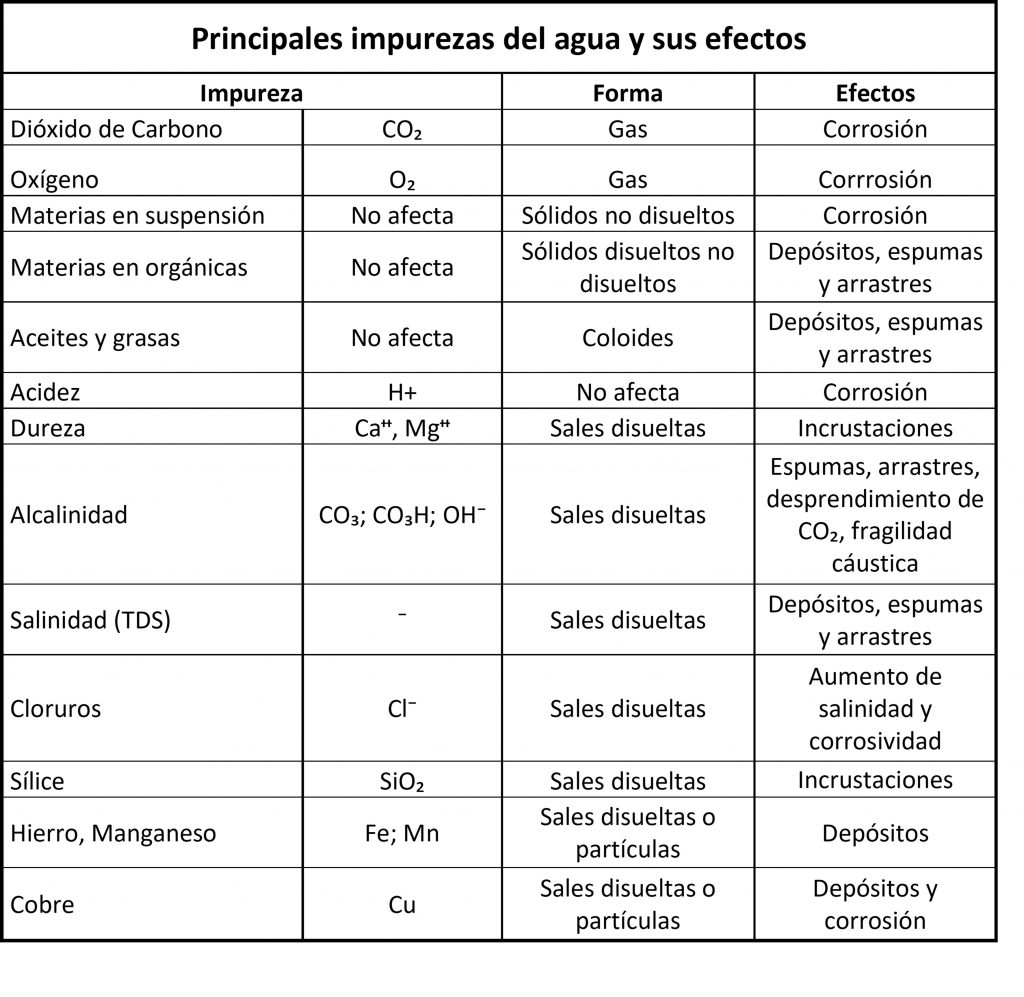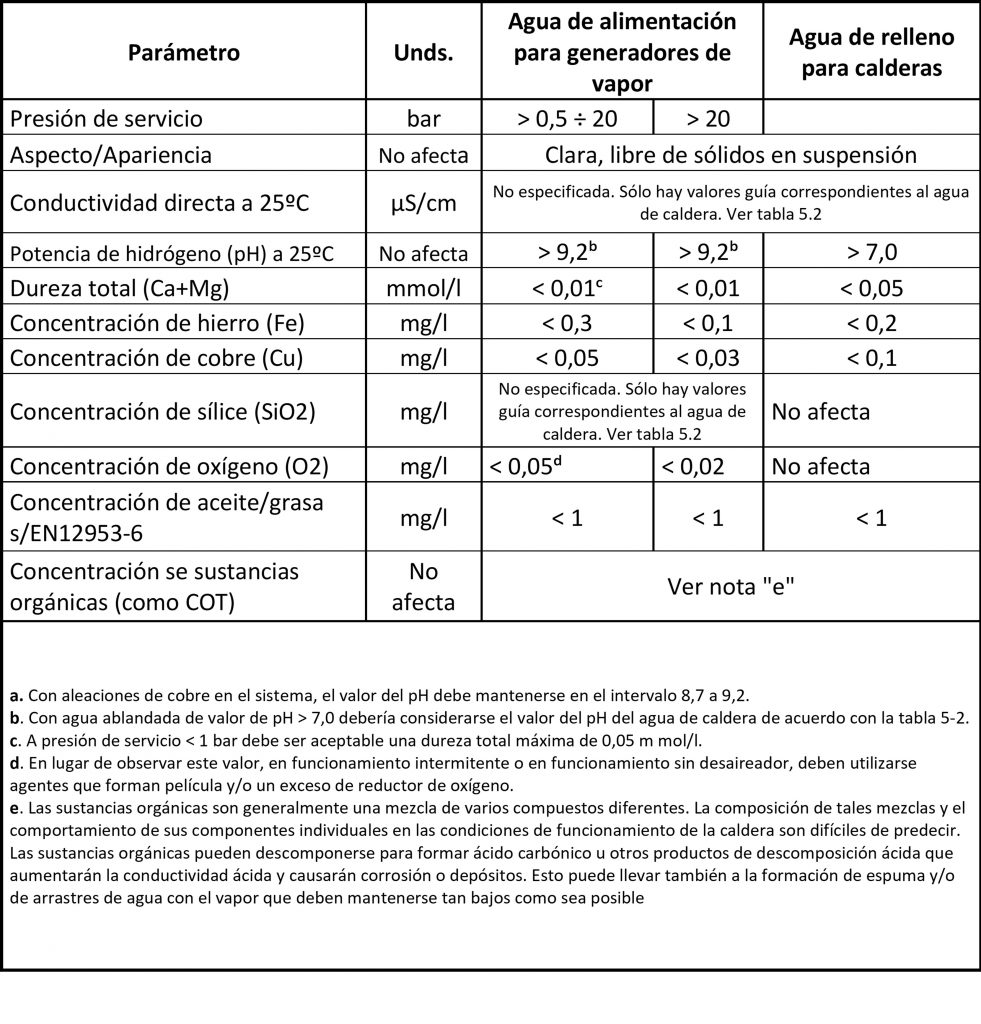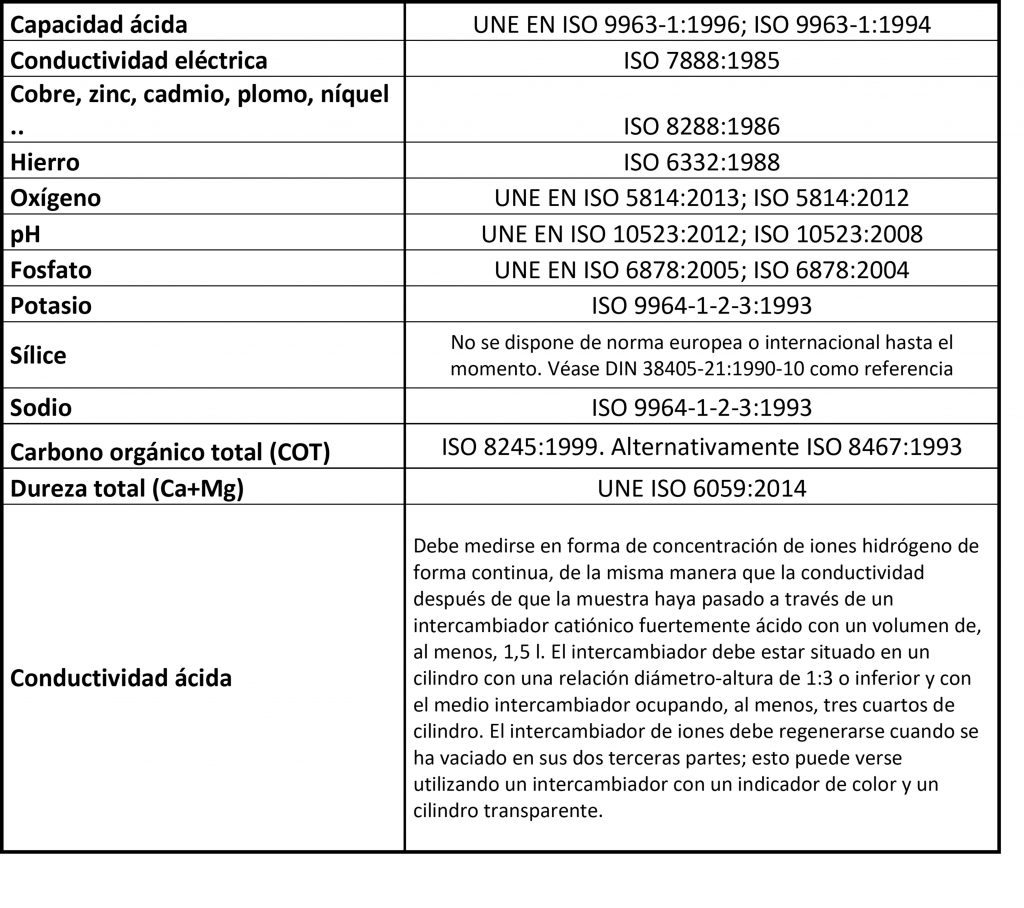Boiler water
In the article we discuss the importance of water treatment in steam generators and boilers. We would like to point out that feed water naturally contains impurities such as gases, mineral compounds and inorganic particles that can negatively affect the performance and service life of steam boilers.
These impurities can cause fouling, corrosion and creep, which in turn can lead to efficiency losses and increases in fuel consumption. To prevent these problems, the article suggests several measures to further extend the service life of steam generators.
1.1 Treatment
Feedwater is crucial to the lifespan and operation of a steam generator. Natural waters contain the following impurities:
- Dissolved gases (carbon dioxide, oxygen, etc.).
- Mineral compounds (calcium salts, magnesium salts, silica, and sodium).
- Inorganic particles in suspension.
- Organic substances on certain occasions.

These impurities can cause the following effects:
- Incrustations: On heating surfaces such as hearth, plates, tubes, etc., hindering the cooling of the steel and, consequently, the rupture of some of these elements. Likewise, the heat exchange is reduced, resulting in a loss of performance and an increase in fuel consumption.
- Corrosions: Chemical attacks on the walls, especially in places with little water circulation, due to oxygen, acids, etc.
- Carryover: Water with the steam coming out of the boiler.
These incidents can be prevented in the following ways:
- Eliminating harmful substances contained in the water.
- By adding to water reagents capable of converting them into soluble and harmless substances. Attention in the agri-food sector!
- Checking the quality of the feed water and boiler water thoroughly and in detail every day.
1.2 Control
The analysis of the feed water should determine us:
Hydrothymetric title (HT) or degree of hardness.
It indicates the hardness of the water. Water is very hard when it contains lime and magnesium salts (in the form of bicarbonate) at boiling temperature (50 to 100ºC). In order to avoid these incrustations, it is necessary that the Hydrotymetric Title of the feed water be lower than 1 TH (French grade), which corresponds to 10 gr. of calcium carbonate (CO3Ca), per cubic meter of water.
Alkalimetric titer (TA) (p).
Indicates the degree of alkalinity in water in the form of carbonate of soda (CO2Na) or caustic soda, NaOH. This analysis will be advantageously replaced by CT. ITA= 50ppm NaOH=5p
Complete alkalimetric titer (TAC) (m).
It measures the total alkalinity value of the boiler water and its concentration. The TAC value determines the percentage of purges to be carried out in order to avoid the phenomenon of creep and corrosion. For a boiler at a working pressure of 8 kg/cm², the TAC must not exceed 1,400 mg/l. The higher the pressure, the lower the CT should be.
ONE TAC = 50 PPM CO3Ca = 5m
Power of Hydrogen (pH).
It is the number of free hydrogen ions in solution, and indicates the greater or lesser basicity or acidity of the solution. Thus:
- – pH < 7, is acidic
- – pH = 7, neutral
- – pH > 7, is alkaline
At a solution temperature of 25°C, the boiler water will be very alkaline (see tables for exact values).
Salinity (T.S.D.).
It expresses the total concentration of dissolved salts in water. Its unit is the milligram per liter, mg/l (1 mg/l = 1ppm).
Recommended values for feed water.
The values of the highest permissible concentrations of a certain number of impurities and of the maximum and minimum concentrations of chemical agents to be added in order to minimize corrosion, sludge formation and deposits should be in accordance with Tables 5-1 and 5-2 and Figures 5-1 and 5-2.




1.3 Other requirements
The operating conditions of a boiler and/or the choice of certain materials or a special design may result in an additional limitation for some of the parameters specified in the tables or require specialist advice to adjust the new control parameters. Such special considerations include:
- Cracks and/or phase separation boundaries subjected to thermal flow;
- Operation at pressures well below design pressure;
- Materials other than carbon steels, e.g. stainless steel.
The cooler spray water, if any, for steam temperature control should be demineralized water and/or uncontaminated condensate dosed only with volatile chemical agents. The required steam quality should not be adversely affected.
The intended use of the heated water or steam should require additional quality constraints. If it is used, for example, in the pharmaceutical or food industry or to feed steam turbines, special requirements for steam quality may be necessary. The strictest requirements of the individual application must be met.
The set values must be applied for continuous operation. During startup, shutdown or major changes in operation, some values may deviate from the normal value for a short period of time and up to a limited extent depending on the operating parameters and the type of boiler.
The manufacturer should specify the extent or magnitude of any possible deviation. The values should be brought within the limits of continuous operation as soon as possible.
When the specified values deviate during continuous operation, this may be due to:
- Faulty treatment of backfill water
- Insufficient conditioning of feed water
- Water contamination caused by leaking impurities from other systems, e.g. condensers, heat exchangers, etc.
- Corrosion of certain parts of the installation
To ensure proper operation, appropriate modifications should be made immediately. For example, recycled feed condensate should not adversely affect feed water quality and should be purified if necessary.
The chemical composition of the boiler water in the “boiler” boilers can be controlled by dosing the conditioning chemicals as well as by continuous or continuous blowdown.
intermittent removal of a proportion of the water volume, which must be done in such a way that both dissolved and suspended impurities can be removed.
1.4 Chemical composition test
General
To ensure that proper chemical conditions prevail, quality parameters should be checked periodically and/or continuously. The cooler spray water, feed water and boiler water in steam boilers and boiler water in hot water boilers must be checked for the relevant parameters such as pH, direct conductivity, acid conductivity, hardness and oxygen or oxygen reduction.
The boiler manufacturer should specify the frequency of such tests in the operating instructions. NOTE – If reliable continuous recording analyzers are used, the frequency of manual water quality checks can be reduced.
Sampling
Sampling of water and steam from the boiler system should be performed according to ISO 5667-1 and sample preparation and handling according to ISO 5667-3.
Sampling points
Sampling points should be located at sites representative of the system. Typical sampling point locations are:
- – Inlet valve feed water;
- – Boiler water from a downpipe or continuous blowdown line;
- – Backfill water downstream of the backfill water treatment facility or storage tanks;
- – Condensate from the condenser outlet, if any; otherwise, the condensate should be sampled at a point as close as possible to the feed tank.
1.5 Analysis
General
Proof of compliance with the values given in Tables 5.1 to 5.2 should be provided in accordance with written procedures applying the methods of analysis described in Section 7.3, where possible. If analyses are performed according to other standards or by indirect methods, calibrations must be made for these methods.
NOTE 1 – In some types of water, the amount of dissolved matter can be estimated from the conductivity. For fully demineralized water, it is possible to obtain a Ph value from the correlation between the direct and acid conductivities.
NOTE 2 – Preferably, continuous operation monitors should be installed for the main parameters. Periodic laboratory checks are essential and are sometimes the only possible test.
Visual criteria
Changes in the appearance or appearance of the water in relation to suspended solids, color or foam may indicate that uncontrolled changes have occurred or are about to occur in the facility.
Methods of analysis
Except in cases of force majeure, the parameters must be checked in accordance with the following rules:

1.6 Need to blowdown the boiler
Even if the boiler is fed with water softened in a water softener, a large quantity of mineral salts enters the boiler, since only an ionic transformation takes place in the water softener, preventing the salts dissolved in the water (calcium carbonate and sodium carbonate) from adhering to the walls of the boiler.
As they do not adhere to the boiler walls, these mineral salts accumulate at the bottom, forming sludge that must be removed by blowdowns. These salts decrease the thermal transmission from the steel to the water, which in turn produces an increase in the temperature of the furnace and boiler tubes, which could lead to a loss of their mechanical resistance and a considerable reduction in the performance of the equipment.
These disadvantages are eliminated by frequent blowdowns during the working day (i.e. with the boiler pressurized), which will generally be as follows:
- At the beginning of the day, a 5-second purge of the bottom valve and a 2-second purge of the accessories (levels, level bottle, etc.).
- Every two hours, repeat the process
- At the end of the working day, repeat the process.
Even following these indications, the blowdown regime could be insufficient, as it depends to a large extent on the quality of the supply water and the steam consumption profile. In this case, it is necessary to take periodic samples of the inside of the boiler and measure its salinity, modifying the periodicity of the purges to maintain the values set by the current regulations and indicated in this appendix.
It is not recommended to completely empty the boiler if it has recently been in operation and is still above ambient temperature, as this could lead to hardening of the sludge and internal incrustations that would make it difficult to remove later.
In summary, feedwater treatment and monitoring are crucial to the efficient operation and longevity of steam generators and boilers.
Do you need technical advice? Contact Giconmes to guide you in the maintenance and service life of your steam generator.